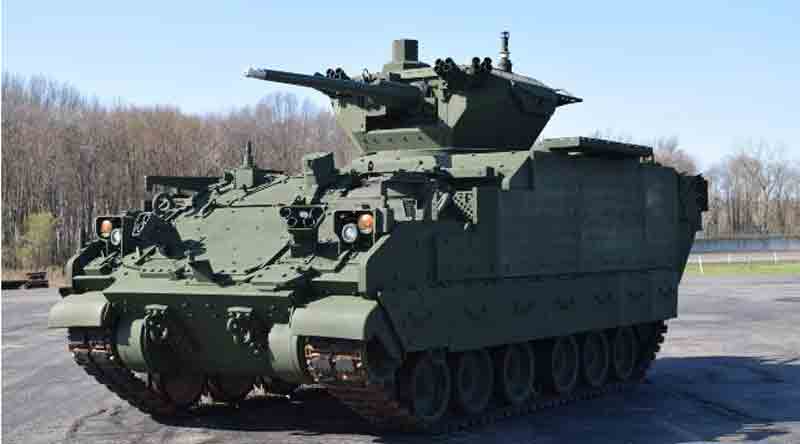When the world’s leading military concludes that the future of combat lies in agile and versatile platforms rather than in massive tanks, what implications does this have for global battlefields? A recent assertion from the Ukrainian online outlet Defense Express indicates that the U.S. Army‘s current transformation, which emphasizes adaptability for potential conflicts in the Pacific over conventional heavy armor, might inadvertently benefit Ukraine’s military efforts.
A report referencing a letter from Glenn Dean, the executive director of the U.S. Army’s Ground Combat Systems program, suggests that the cancellation of various armored vehicle initiatives and a reduction in others could allow Ukraine to obtain advanced systems such as the Armored Multi-Purpose Vehicle (AMPV). Although these assertions have not been verified by U.S. officials, they underscore a critical juncture in military strategy that could alter alliances and conflicts from Eastern Europe to the Indo-Pacific.
The essence of the Defense Express report, released by the Ukrainian source, centers on a letter reportedly acquired by Breaking Defense, a U.S.-based defense news outlet. This letter, attributed to Glenn Dean, purportedly details the U.S. Army’s choice to cease the development and procurement of several ground combat systems, including the M10 Booker light tank, a new self-propelled howitzer, and additional orders for vehicles such as the Humvee, Joint Light Tactical Vehicle (JLTV), and Stryker armored personnel carrier.
The report implies that these cancellations are part of a larger strategic shift aimed at preparing for warfare in the Pacific, where heavy armor is less effective for the island-hopping and rapid-deployment scenarios anticipated in a potential conflict with China. Rather than investing in these platforms, the U.S. Army is reportedly reducing production of the AMPV to a minimum sustainment level, potentially allowing Ukraine to purchase surplus units to enhance its military capabilities.
The AMPV, manufactured by BAE Systems, is a 36-ton tracked armored vehicle based on the M2 Bradley Fighting Vehicle, but it lacks the characteristic turret. It is designed to replace the outdated M113 armored personnel carrier, providing improved mobility, protection, and versatility. The AMPV is available in five configurations: a general-purpose troop carrier capable of transporting six soldiers, a medical evacuation vehicle, a medical treatment vehicle for field surgeries, a mission command vehicle for battlefield coordination, and a mortar carrier equipped with a 120mm mortar.
Its design emphasizes survivability against mines, improvised explosive devices, and direct fire, sharing a common powertrain and suspension with the Bradley and the M109A7 Paladin howitzer to facilitate maintenance and logistics. Since its full-rate production began in 2023, the AMPV has been recognized as a key element of the U.S. Army’s modernization strategy, with plans to deploy nearly 3,000 units over the next twenty years.
According to Defense Express, the U.S. Army’s decision to cut back on AMPV production may enable Ukraine to obtain these vehicles through a “backfill” arrangement, where surplus or redirected units are sold to allies. This approach is seen not just as an economic transaction but as a strategic opportunity for the U.S. to evaluate the AMPV in actual combat scenarios against Russian forces.
The report emphasizes the vehicle’s versatility, mentioning that BAE Systems has created configurations beyond the standard variants, including a counter-unmanned aerial system (C-UAS) version for drone defense and a potential infantry fighting vehicle variant with a modular turret. One configuration features the 120mm NEMO mortar system from Finland’s Patria, which offers automated loading and a firing rate of 10 rounds per minute, providing substantial firepower for mobile units.
The development of the AMPV is rooted in a significant historical context. The M113, which the AMPV is set to replace, has been a fundamental asset for U.S. and allied forces since the 1960s, participating in various conflicts from Vietnam to Iraq. However, its lightweight armor and restricted mobility revealed weaknesses in contemporary warfare, especially during urban combat in Iraq, where it faced challenges from improvised explosive devices and rocket-propelled grenades.
Initiated in 2014 with a $383 million contract awarded to BAE Systems, the AMPV program sought to rectify these issues by utilizing the proven chassis of the Bradley while integrating modern electronics, improved armor, and future technology compatibility. By 2023, the 1st Armored Brigade Combat Team of the 3rd Infantry Division had received its initial AMPVs, signifying a key advancement in the Army’s modernization of its Armored Brigade Combat Teams.
Additionally, a report from Defense Express highlights the wider implications of the U.S. Army’s transformation. The cancellation of the M10 Booker, a light tank intended to deliver mobile firepower for airborne and infantry units, indicates a reevaluation of the Army’s requirements. Designed to fill the gap between heavy tanks like the M1 Abrams and lighter vehicles, the Booker was criticized for its limited effectiveness in Pacific operations, where rapid deployment and logistical challenges favor smaller, more adaptable platforms.
As noted in a Defense One article, Alex Miller, the Army’s chief technology officer, characterized the Booker as a result of bureaucratic inertia rather than a strategic need, emphasizing that the Army was already reassessing its role prior to the cancellation announcement.
The decision to cease orders for the Humvee, JLTV, and Stryker indicates a transition towards next-generation technologies, including autonomous vehicles and hybrid-electric systems, which offer improved fuel efficiency and stealth capabilities. For Ukraine, the potential acquisition of AMPVs could significantly alter the battlefield dynamics.
Since Russia’s invasion in 2022, Ukraine has heavily depended on equipment supplied by the West, receiving over 900 M113s from U.S. reserves alone. Although the M113 has been effective as a troop transport, its weaknesses have led Ukraine to pursue more advanced platforms. The AMPV, with its superior protection and modular design, could meet these requirements, especially in countering the increasing threat posed by Russian drones.
Defense Express suggests that the C-UAS variant, which includes sensors and jammers to combat unmanned aerial threats, could safeguard Ukrainian assault groups and armored units during operations. Furthermore, the NEMO mortar variant could deliver swift and accurate fire support, a vital resource in the dynamic, high-intensity confrontations along Ukraine’s eastern front.
The U.S. Army’s shift towards the Pacific is influenced by the distinct challenges presented in that region. Unlike the expansive terrains of Eastern Europe, where heavy tanks like the Abrams thrive, operations in the Pacific necessitate forces capable of rapid deployment across extensive distances, functioning from small islands, and maintaining operations with limited logistical resources.
The cancellation of programs such as the M10 Booker and the decrease in Stryker orders reflect this new focus, as does the Army’s commitment to lighter, hybrid-electric vehicles. For instance, the Optionally Manned Fighting Vehicle (OMFV), intended to replace the Bradley, has prompted contractors like BAE Systems and General Dynamics to develop smaller, hybrid-electric designs equipped with active protection systems to defend against anti-tank missiles.
These advancements are in line with the Army’s overarching initiative towards automation and unmanned systems, exemplified by the Robotic Combat Vehicle program designed to minimize soldiers’ exposure to enemy fire. The Defense Express report also raises concerns regarding the industrial ramifications of the U.S. Army’s choices. BAE Systems, which manufactures the AMPV at its facility in York, Pennsylvania, has made significant investments to enhance production capacity, including $27 million from Ukraine’s supplemental funding and $250 million in internal resources.
A report from Breaking Defense highlighted that these investments have facilitated the acquisition of new robotic welding machines and other enhancements, allowing BAE to produce as many as 197 AMPVs each year. However, the anticipated decrease in AMPV production may jeopardize the company’s plans, especially if potential purchases from Ukraine do not come to fruition.
The report indicates that BAE is considering international markets, showcasing AMPV variants equipped with modular turrets and advanced electronics to entice buyers such as Ukraine and other NATO partners. On a global scale, the U.S. Army’s transition has ignited discussions among allies and adversaries.
NATO countries like Poland and Germany are continuing to invest in heavy armor, with Poland procuring hundreds of M1 Abrams tanks and Germany modernizing its Leopard 2 fleet. This divergence may complicate joint operations, as European forces emphasize traditional land warfare while the U.S. concentrates on expeditionary capabilities.
Meanwhile, adversaries like China are intensifying their focus on heavy platforms, with the People’s Liberation Army deploying advanced tanks such as the Type 99A, which features a 125mm smoothbore gun and active protection systems. This disparity underscores a potential imbalance: while the U.S. prioritizes flexibility, its competitors are gearing up for attrition-based warfare.
Historically, the United States has leveraged conflicts involving its allies to enhance its weaponry. In the 1970s, the deployment of American-provided M60 tanks and F-4 Phantom jets by Israel during the Yom Kippur War yielded critical insights that influenced future military designs. Likewise, the ongoing situation in Ukraine may act as a testing environment for the AMPV, especially its counter-drone and mortar models.
A report from Defense Express suggests that the practical experiences of Ukrainian forces could impact future decisions made by the U.S. Army, potentially affirming or questioning the move away from heavy armored vehicles. This situation highlights the interdependent nature of U.S. relations with its allies, where military assistance also serves as a platform for innovation. The timeline for AMPV production introduces additional complexities.
Defense Express indicates that BAE Systems has obtained contracts totaling $1.6 billion for 628 vehicles, with each unit costing around $6.9 million. The initial production goal was set at 91 units for 2024, decreasing to 81 in 2025, before increasing to 122 annually in 2026 and 2027.
However, the reported cutbacks to minimum sustainment levels may disrupt this timeline, raising concerns about the number of AMPVs Ukraine could feasibly obtain and their associated costs. The report also highlights that many of these specifics remain uncertain, including the conditions of any potential backfill agreement. While the claims made by Defense Express are compelling, they come with important caveats.
The report is based on a single letter from Glenn Dean, the details of which have not been independently verified by U.S. sources. Furthermore, Breaking Defense, which is cited as the source of the letter, has not released the full document, and U.S. Army officials have not provided comments regarding the alleged cancellations or the backfill arrangement with Ukraine.
The absence of confirmation highlights the speculative aspect of the report, particularly due to the lack of information regarding how Ukraine plans to finance or incorporate the AMPV into its military. Additionally, the U.S. Army’s transformation remains uncertain, with industry insiders voicing doubts about the extent of the proposed reductions.
From a wider viewpoint, the Defense Express report sheds light on a pivotal moment in U.S. military strategy. The move away from heavy armor signifies a daring, albeit risky, gamble on the future of warfare, where agility, stealth, and adaptability are prioritized over sheer force.
For Ukraine, the potential acquisition of AMPVs presents an exciting opportunity for improved capabilities, yet it relies on unverified commitments and intricate logistics. The success of this transformation may ultimately be tested on the battlefields of Eastern Europe, where the AMPV could encounter its first significant challenges.
As both allies and adversaries observe closely, a critical question remains: can the U.S. Army’s shift towards flexibility sustain its advantage in a landscape still characterized by armored dominance?
Discover more from Defence Talks | Defense News Hub, Military Updates, Security Insights
Subscribe to get the latest posts sent to your email.





